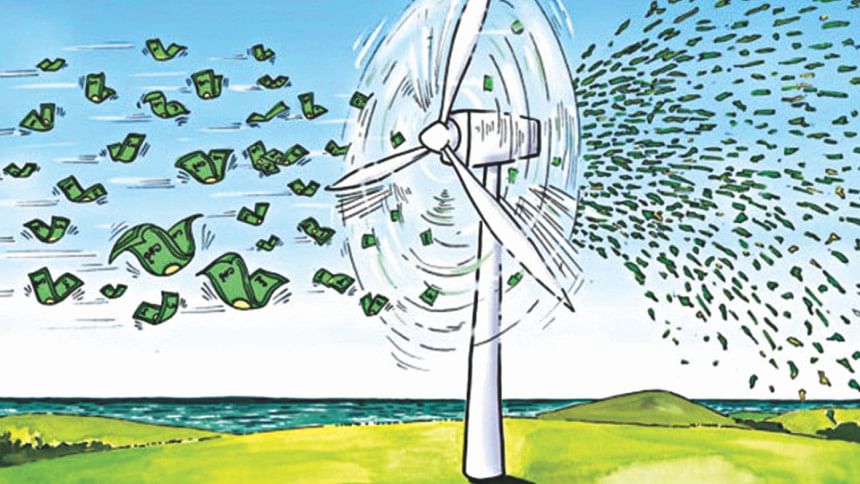No winds of change

Riding on the long bull-run of 2017, investors in Bangladesh's stock exchange may have thought that perhaps the year 2018 will not be too bad either. After all if past record is any guide, election years typically mean more money being pumped into the market.
Sadly though, it didn't take long to douse that flame of optimism: the market returned to its pre-2017 era of tumbling prices and sluggish activity, sprinkled with rare episodes of price hikes which disappeared in the blink of an eye.
No one needs reminding that the stock market had been in doldrums for years after the infamous crash of 2010. This made the 2017-rally of 20-plus percent even more unnerving since we did not see fundamental changes like increase in company listings and regulatory overhauls. In fact a rally of such magnitude is more a cause for concern than celebration because what goes up must come down if it's not standing on firm footing.
So then it should not really come as a surprise that the general market index, DSEX, fell by around 15.1 percent in 2018 (as of December 24). The DS30, which is an index of 30 blue-chip companies representing around half of total market capitalisation, fell by a whopping 18.8 percent during the same period. In other words, the supposedly high-quality companies dragged down the market. And sure enough both value and volume of traded activity fell by fair amounts this year, yet again undermining the overall loss of public confidence.
What triggered such a big fall in market prices and general sentiment during a year when GDP growth was 7.9 percent, inflation remained low and investors witnessed the historic entry of a Chinese consortium, comprising Shenzhen Stock Exchange and Shanghai Stock Exchange, as strategic partner of DSE?
The problem was the same: no winds of change.
First, almost characteristic of our market, we saw irrational episodes of rapid price hikes of fundamentally weak companies while prices of several "A" category stocks fell despite offering dividends. In other words, the market remained in the grip of rumour-based activity by unscrupulous gamblers while genuine investors ran for cover.
Second, the market still feels the pinch of financial sector volatility but does not gain from expansions in the real sector (i.e. manufacturing sector which produces real goods as opposed to financial products). Since financial institutions constitute a large portion of total market value, the ongoing liquidity crisis and rising non-performing loans in the banking sector dented confidence and trading volume. Exchange rate volatility and rising political tensions before national election only added fuel to the fire.
Meanwhile, without enough quality stocks from the real sector, the market did not rally from a 14 percent expansion in the manufacturing sector which actually drove GDP growth. Sadly though ambitious dreams like listing big local and multinational corporations (MNC) remain just that—a dream. Sooner or later authorities will have to design an incentive structure that makes these firms go public. We remain convinced that the ramifications of listing MNCs will be massive: more confidence, greater liquidity, higher foreign money and less sensitivity to banking sector volatility to name a few.
But that's just the beginning. Unfulfilled promises remain a hallmark of our capital market. Take the case of speculative trading by gamblers. Year in year out we hear authorities promise to remedy this toxic-deterrent to long-term market stability. Yet every year we turn away disappointed, 2018 was no different.
Lack of coordination among regulators can no longer be an excuse if authorities are serious about bringing change.
Every year we hear grandiose visions of creating a vibrant bond market during the annual budget meetings. And every year we are disappointed when these visions do not translate to reality, leaving us only with paltry tax cuts randomly distributed across various sectors. This year was almost the same except that multi-layered taxation on dividend income was scrapped. Essentially, companies will no longer have to pay tax again on the taxed dividend income after its distribution to shareholding resident companies.
Perhaps this was too little too late, or just simply too little an incentive to improve market sentiment. Most likely it was the latter since the market is still marred by several other notable problems. For instance, we are yet to see any law that protects general investors in case a company gets delisted from the market. Nor have we seen concrete initiatives to educate ordinary citizens on the benefits of long-term investing instead of going in to make quick and easy money. Add to that many companies do not even disclose all financial information required of a listed company in their websites and you can understand why ordinary citizens lack conviction in the market.
It would be remiss not to mention that regulators have done little to improve investor awareness and confidence in mutual funds. To be sure professionally-managed wealth does hold a lot of promise, but the overall supervision and governance of this sector remain shaky. For instance, the regulator's advice to extend the maturity of 30 close-end mutual funds without consulting general investors will hurt confidence, not build it.
At the end of the day, genuine investors will only believe in the market if they can believe in market regulators. How can that happen when regulators have not lived up to their promises? Those of us following the market can only hope for some winds of change next year.
Sharjil Haque is a Doctoral student in Economics at the University of North Carolina, USA and former Research Analyst, International Monetary Fund, Washington DC.

 For all latest news, follow The Daily Star's Google News channel.
For all latest news, follow The Daily Star's Google News channel. 



Comments